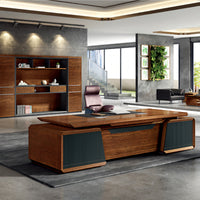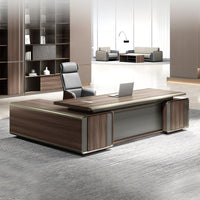How To Set Up Computer with Executive Desk?
kaguyasuContent Menu
● Choosing the Right Executive Desk
>> What Makes an Executive Desk Different?
>> Consider Desk Dimensions and Layout
● Ergonomic Setup for Comfort and Health
>> Desk and Chair Positioning
>> Monitor Placement
● Organizing Your Computer Setup
>> Choosing the Right Computer Equipment
>> Cable Management
>> Additional Accessories
● Enhancing Productivity and Aesthetics
>> Minimalist vs. Functional Design
>> Personalization
>> Lighting Considerations
● Step-by-Step Guide to Setting Up Your Computer with an Executive Desk
>> Step 1: Prepare Your Workspace
>> Step 2: Position Your Desk and Chair
>> Step 3: Set Up Your Computer and Monitor(s)
>> Step 4: Organize Cables and Accessories
>> Step 5: Final Adjustments
● Common Mistakes to Avoid
● Frequently Asked Questions
● Citations:
Setting up a computer with an executive desk involves more than just placing your PC on a surface. It requires thoughtful planning regarding ergonomics, aesthetics, functionality, and productivity. This comprehensive guide will walk you through the steps to create an efficient, comfortable, and stylish workspace that maximizes your executive desk's potential.

---
Choosing the Right Executive Desk
What Makes an Executive Desk Different?
Executive desks are typically larger, sturdier, and more elegant than standard desks. They often feature high-quality materials such as solid wood or metal, with additional storage options like drawers and cabinets. The size and design should complement your office space while providing ample room for your computer and accessories.
Consider Desk Dimensions and Layout
- Size: Ensure the desk is deep enough (at least 60 cm or 2 feet) to accommodate your monitor(s), keyboard, and other peripherals comfortably.
- Shape: Rectangular desks are common, but L-shaped or U-shaped desks can provide additional workspace and storage.
- Storage: Decide if you need drawers or filing cabinets integrated into the desk for organization.
---
Ergonomic Setup for Comfort and Health
Desk and Chair Positioning
- Desk Height: The desk surface should allow your forearms to rest parallel to the floor when typing, with elbows at about a 90-degree angle.
- Chair: Use an ergonomic chair that supports your lower back, allows feet to rest flat on the floor, and promotes good posture.
- Legroom: Ensure there is enough space under the desk for your legs to move freely.
Monitor Placement
- Distance: Place your monitor about an arm's length away to reduce eye strain.
- Height: The top of the screen should be at or slightly below eye level to avoid neck strain.
- Dual Monitors: If using two screens equally, center them between your body midline; if one is primary, center that screen and place the secondary to the side.
---
Organizing Your Computer Setup
Choosing the Right Computer Equipment
- Computer Type: Decide between a desktop or laptop based on your needs. Desktops offer more power and upgrade options; laptops provide portability.
- Peripherals: Opt for wireless keyboards and mice to reduce cable clutter.
- Monitors: Select monitors based on your work requirements—color accuracy for professionals, high refresh rates for gamers, or general use monitors for everyday tasks.
Cable Management
- Use cable trays, clips, or sleeves to keep wires organized and out of sight.
- Consider desks with built-in cable management features to maintain a clean look.
Additional Accessories
- Docking Stations: Useful for laptop users to connect multiple peripherals easily.
- Speakers or Headsets: For video calls or multimedia.
- Desk Lamps: Adjustable lighting reduces eye strain and improves focus.
---
Enhancing Productivity and Aesthetics
Minimalist vs. Functional Design
- Minimalist Setup: Keep only essential items on your desk to reduce distractions and clutter.
- Functional Setup: Include necessary tools and documents within arm's reach but organized neatly.
Personalization
- Add personal touches like plants, artwork, or photos to make the space inviting without overcrowding.
Lighting Considerations
- Position your desk near natural light sources if possible.
- Use adjustable task lighting to illuminate your workspace without glare.
---
Step-by-Step Guide to Setting Up Your Computer with an Executive Desk
Step 1: Prepare Your Workspace
- Clear the desk surface.
- Measure the available space to plan equipment placement.
Step 2: Position Your Desk and Chair
- Place the desk facing a wall or window depending on your preference.
- Adjust your chair height so your feet rest flat and your arms align with the desk surface.
Step 3: Set Up Your Computer and Monitor(s)
- Place your monitor(s) at the recommended height and distance.
- Connect your computer, keyboard, mouse, and other peripherals.
Step 4: Organize Cables and Accessories
- Route cables neatly using management tools.
- Arrange accessories such as a phone, notepad, or lamp within easy reach.
Step 5: Final Adjustments
- Adjust lighting to reduce glare on screens.
- Test your setup for comfort and efficiency, making ergonomic tweaks as needed.
---
Common Mistakes to Avoid
- Placing monitors too high or low causing neck strain.
- Overcrowding the desk with unnecessary items.
- Ignoring cable clutter, which can cause distractions and accidents.
- Using a non-ergonomic chair leading to discomfort and health issues.
---
Frequently Asked Questions
Q1: What is the ideal height for an executive desk?
A: The desk height should allow your elbows to be at a 90-degree angle when typing, typically between 28 to 30 inches (71 to 76 cm).
Q2: Should I use a standing desk with an executive desk?
A: Standing desks offer ergonomic benefits, but if your executive desk is fixed, consider a sit-stand converter to alternate between sitting and standing.
Q3: How far should my monitor be from my eyes?
A: About an arm's length (20-30 inches or 50-75 cm) to reduce eye strain.
Q4: What type of chair is best for an executive desk setup?
A: An ergonomic chair with adjustable height, lumbar support, and comfortable cushioning is ideal.
Q5: How can I keep my executive desk setup minimal yet functional?
A: Use wireless peripherals, organize cables, and keep only essential items on the desk surface.

---
Citations:
[1] https://www.minimaldesksetups.com/minimal-desk-setups-101/
[2] https://www.uwo.ca/hr/form_doc/learning/workstation_guide.pdf
[3] https://www.wired.com/story/work-from-home-home-office-gear-guide/
[4] https://www.mayoclinic.org/healthy-lifestyle/adult-health/in-depth/office-ergonomics/art-20046169
[5] https://www.benq.com/en-us/knowledge-center/knowledge/laptop-desk-setup.html
[6] https://huggingface.co/spaces/wangrongsheng/ChatPaper/commit/912e540bd8c115714151ecef7b0e0a3d94739f62
[7] https://www.youtube.com/watch?v=ZbmlQ4IP7PE
[8] https://learn.microsoft.com/zh-cn/style-guide/scannable-content/headings
[9] https://baike.baidu.com/item/%E5%95%86%E5%8A%A1%E5%86%99%E4%BD%9C%E6%8A%80%E5%B7%A7/8451817
---
Hot Tags: China, Global, OEM, private label, manufacturers, factory, suppliers, manufacturing company











